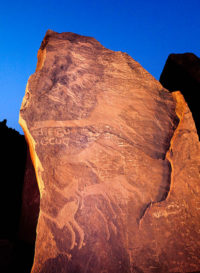Blog Archives
-
Oryx Hunting Scene
This boulder is heavily laden with petroglyphs. It is located just south of The King and Eagle's Nest at Jebel al Sanman, Jubbah.
-
Arabian Oryx
Oryxes are most easily recognized by their prominent horns, which range in length from 480-700 mm. There is little difference in size of the horns of males vs. females. The long, fairly straight horns are basically in line with the straight facial profile, but curve backward slightly. They are annulated, meaning that the horns possess a series of raised rings wrapping around them in [...]
-
Domestic Cattle Panel Detail: Oryx
Click here to download the PTM file. Desktop RTI viewers can be downloaded from Cultural Heritage Imaging.
-
Oryx
01:23 15fps 852 x 480 H.264 10.22 megs
-
Hoodoo, Bir Hima
A delicately balanced block of sandstone (or hoodoo) at the top of this hill attracted the attention of ancient artists in southern Saudi Arabia.






